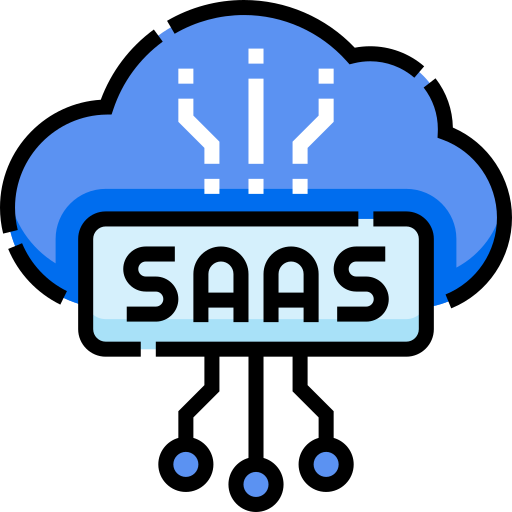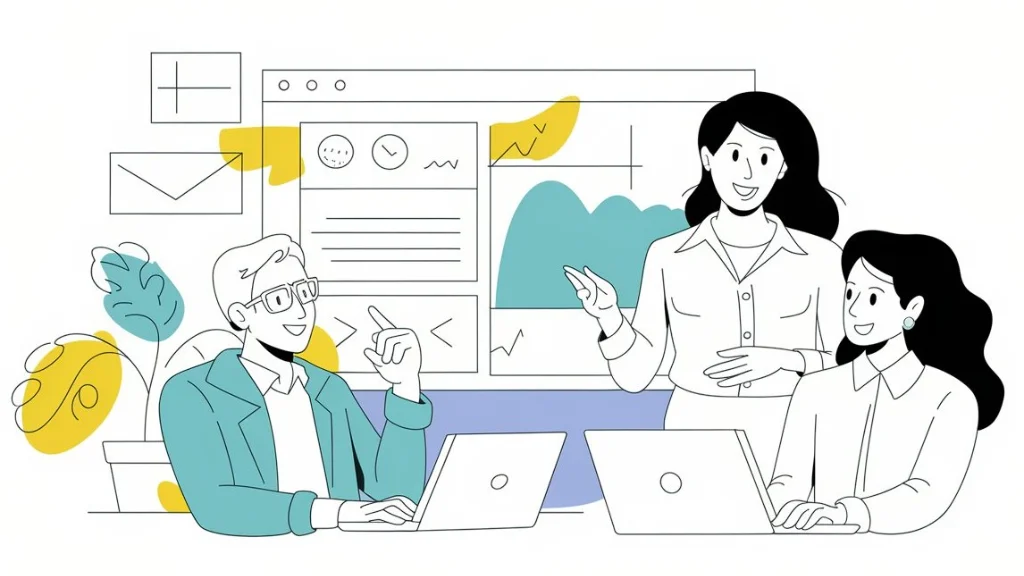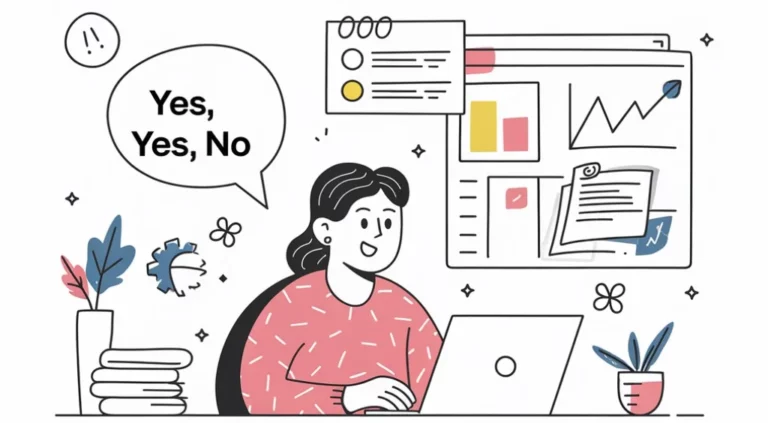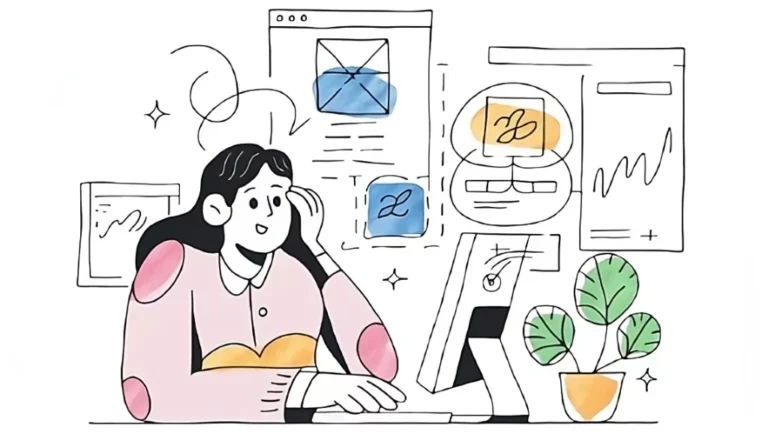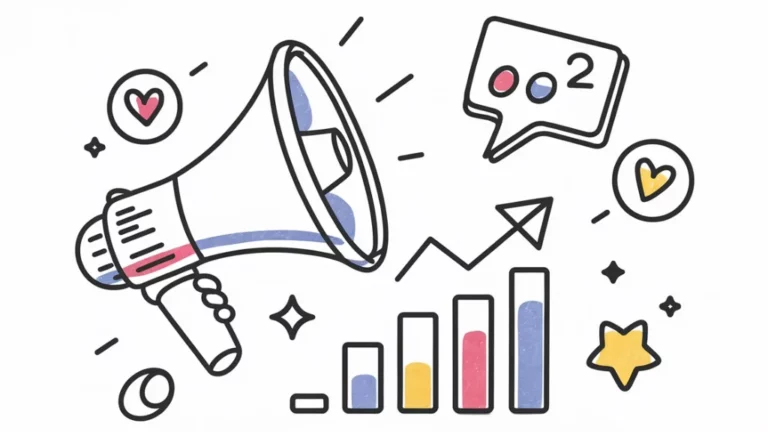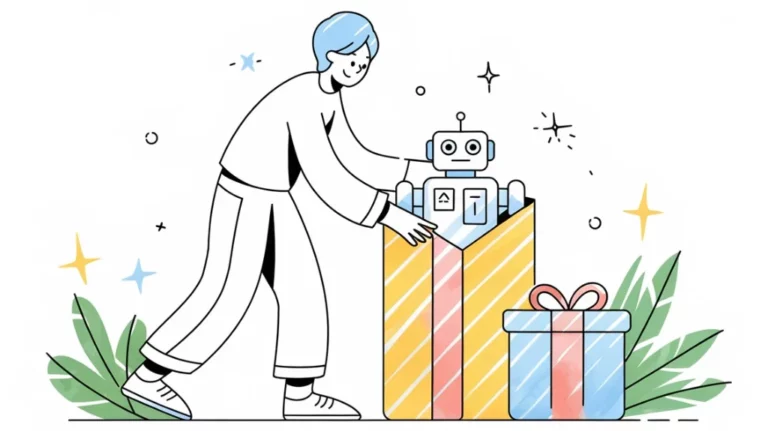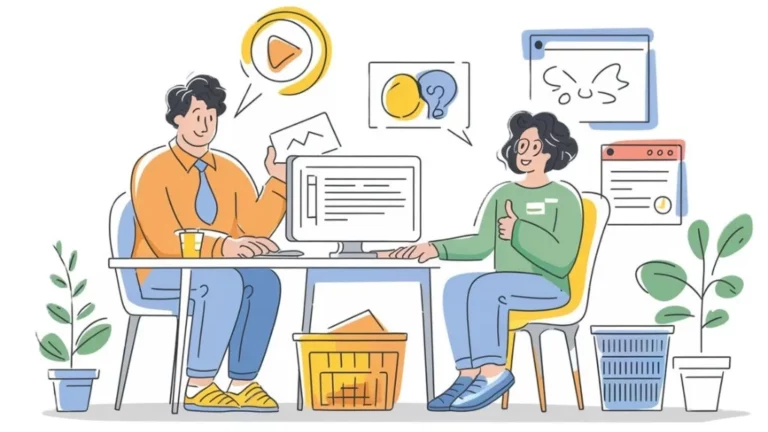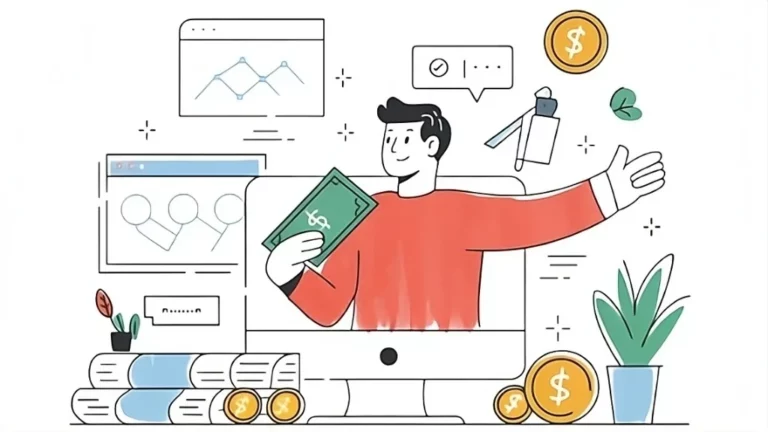Reality distortion debt. It sounds dramatic, doesn't it? Maybe even a bit sci-fi. But for solo SaaS entrepreneurs, it's a very real, and very dangerous, phenomenon. Think of it as the accumulating cost of all your unchecked assumptions about your product, your market, and your users. Every time you assume you know best without validating that hunch with real-world feedback, you're racking up this debt. And just like financial debt, reality distortion debt comes with interest – sometimes crippling interest.
For those brave solo souls venturing into the SaaS world, this debt can be particularly devastating. You lack the buffer of a large team, the cushion of hefty funding rounds, or the diverse perspectives of co-founders to challenge your thinking. A single, unchecked assumption can snowball into a product that nobody wants, leaving you not just financially broke, but also broken-hearted and wondering where it all went wrong. Understanding and actively managing reality distortion debt isn't just good practice; it's absolutely crucial for survival and, dare we say, thriving.
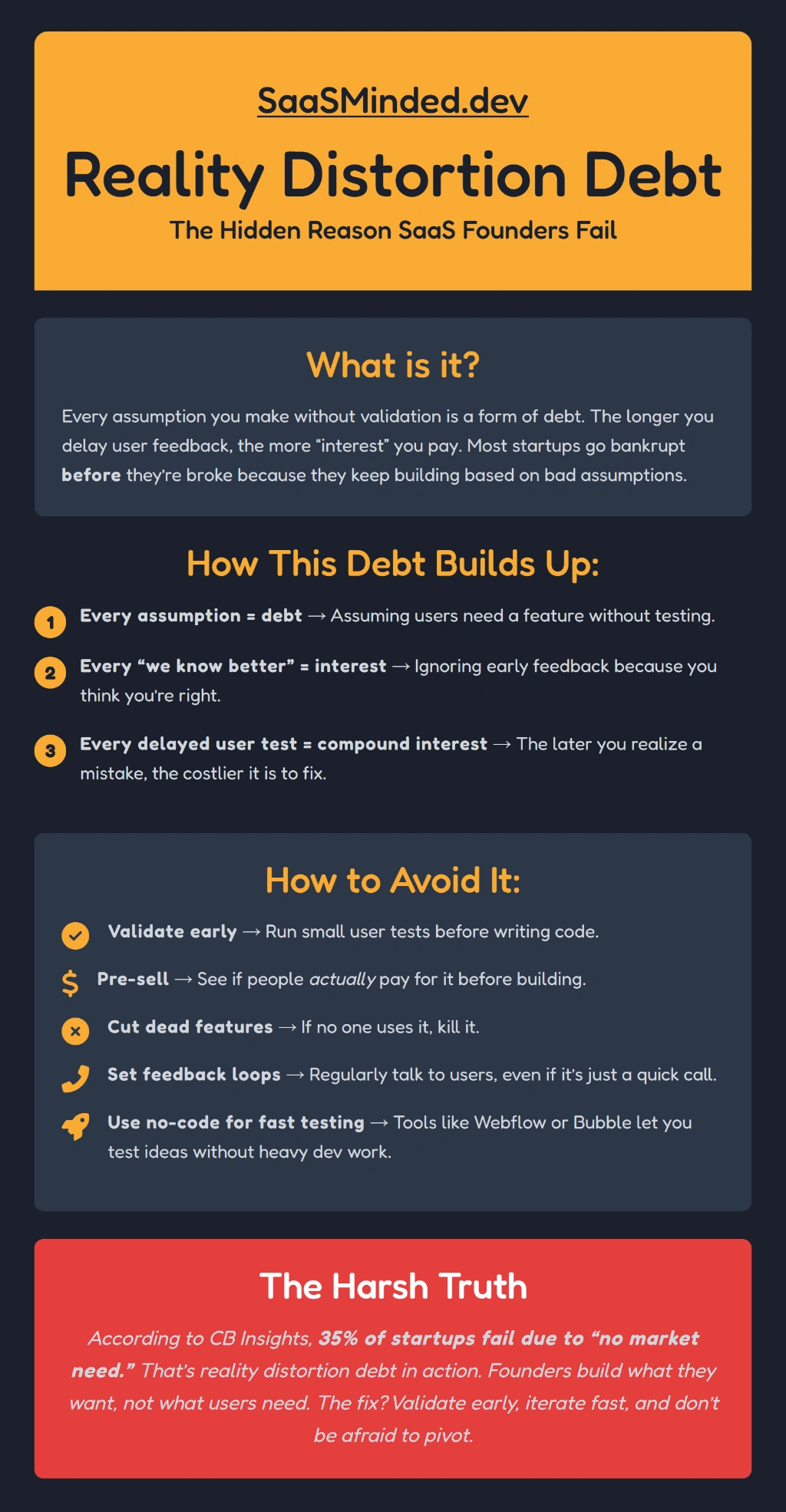
How Do Unvalidated Assumptions Actually Transform into Reality Distortion Debt?
Imagine building a house on a foundation of sand. That’s essentially what happens when you build a SaaS product on a pile of assumptions. Every assumption you make without proper validation becomes an invisible liability, a ticking time bomb in your business model.
Let's say you're a solo SaaS entrepreneur convinced that users will adore a super-minimalist user interface. You skip user testing, pour hours into development, and launch your product. But guess what? Users find it confusing and lacking essential features. That initial assumption about UI preference? It just became a hefty reality distortion debt. Fixing it now means costly redesigns, potential user churn, and lost momentum. Validating that UI early on, even with just a handful of potential users, could have saved you a mountain of trouble.
Consider this sobering statistic: a study by CB Insights revealed that:
35% of startup failures occur due to no market need
Think about that for a moment. No market need. That's not a technology problem, or a marketing problem at its core. It's a reality distortion problem. It's entrepreneurs believing they're building something people desperately want, only to discover the hard way that they were completely off the mark. These failures are often a direct consequence of accumulating assumption debt, believing intuition is enough and ignoring the vital signs from the real world.
Actionable Steps to Start Paying Down Your Assumption Debt Right Now:
- Before you write a single line of code, talk to your potential users. Seriously, pick up the phone, send out emails, do whatever it takes to conduct small-scale user interviews. Even a simple five-person test can illuminate major blind spots you never even considered. Tools like Calendly can make scheduling these chats a breeze.
- Don't just imagine your product; visualize it and test it rapidly. Leverage rapid prototyping tools like Figma or Framer. These platforms allow you to create interactive mockups and put your core ideas in front of users before you commit to development. It’s like test-driving a car before you buy it – crucial for avoiding buyer's remorse, or in this case, builder's remorse.
- Gauge real demand, don't just guess. Set up pre-launch landing pages with signup forms. Use tools like Leadpages or Unbounce. This is your first, real market validation. Are people actually interested enough to give you their email? Or are you just hearing crickets? Actual signups are far more telling than gut feelings.
How Does That Pesky "We Know Better" Mentality Drive Up the Interest Rates on Your Reality Distortion Debt?
Ah, the "we know better" syndrome. It's a common ailment, especially among passionate entrepreneurs. You’ve got a vision, you're excited, and sometimes, you might feel like you know what users need even before they do. While passion is fantastic fuel, unchecked overconfidence can be incredibly dangerous. Every time a solo founder brushes aside market feedback, favoring their own convictions instead, they're essentially racking up interest on their reality distortion debt. It's like ignoring the flashing warning lights on your car's dashboard – you might think you're saving time now, but you're likely heading for a costly breakdown.
The longer you operate with this "we know better" mindset, the more rigid your product becomes, and the harder it is to pivot when reality finally hits. Think of it like this: you're sailing a ship, and the market is the ocean. Customer feedback is your compass and weather reports. Ignoring it because you think you "know better" is like throwing away your navigation tools and hoping for the best. Spoiler alert: the ocean is vast and unpredictable.
A Harvard Business Review report highlighted that:
Companies that integrate customer feedback early grow 2x faster than those that don't
That's not a small difference. Despite this compelling evidence, many solo SaaS founders hesitate to engage with users early. Why? Sometimes it's fear of negative feedback – nobody loves having their baby called ugly. Sometimes it's the belief that they can perfectly anticipate customer needs through sheer brilliance. But the truth is, customer needs are often nuanced, evolving, and frankly, surprising. You're not a mind reader, and neither are we. User feedback is your cheat code to understanding the user's mind.
Actionable Steps to Break Free from the "We Know Better" Trap:
- Automate your feedback collection. Set up automatic user feedback loops right within your SaaS application. Tools like Hotjar, Typeform, or even simple in-app surveys can gather invaluable insights without you having to constantly chase down users. Think of it as having a continuous customer pulse check.
- Make customer calls a monthly ritual. Schedule monthly customer validation calls. Don't just rely on passive surveys. Actually talk to your users. Ask about their pain points, their workflows, what they love, what they hate. Use platforms like Zoom or Google Meet to make these conversations personal and insightful. Treat these calls as gold – because they are.
- Tap into the wisdom of the crowd. Join founder communities like Indie Hackers, MicroConf, or engage in relevant Twitter spaces. These are goldmines of shared experiences, advice, and reality checks from fellow entrepreneurs who've been in the trenches. It's like having a board of advisors without the hefty price tag.
Why Is Delaying User Testing Akin to Compounding the Interest on Your Reality Distortion Debt?
Time is money, especially in the startup world. And in the context of reality distortion debt, time is compounded interest. Delaying user testing is like letting that debt fester and grow exponentially. The later you discover fundamental flaws in your product or your assumptions, the more costly and painful they become to fix.
Imagine you're building a complex feature based on an assumption that users will use it in a specific way. You delay user testing until after months of development. Then, you finally put it in front of real users and… crickets. They don't get it. They don't use it as intended. Or worse, they don't use it at all. Now, you've got to unravel months of work, potentially redesign the feature, and explain to your (possibly dwindling) user base why things are changing yet again. Ouch.
The Standish Group’s Chaos Report dropped a bombshell: "fixing a usability issue post-launch is 100x more expensive than fixing it during early prototyping". One hundred times! Let that sink in. This isn't just about money; it's about time, energy, and morale. When you discover problems late in the game, it affects everything: development timelines get blown, marketing messages become misaligned, customer support teams scramble to handle confused users. It's a ripple effect of pain, all stemming from delayed validation. It’s like trying to fix a major structural problem in a skyscraper after it's already built – exponentially harder and more expensive than addressing it in the blueprint stage.
Actionable Steps to Embrace Early and Frequent User Testing:
- Get real-time user feedback before coding. Utilize platforms like UserTesting or Maze. These services allow you to put prototypes or even just wireframes in front of real users and watch them interact. You get to see their frustrations, their confusion, their "aha!" moments. It's like having a focus group on demand, giving you invaluable insights before you invest heavily in development.
- Launch MVPs early and often. Deploy Minimum Viable Products (MVPs) as soon as humanly possible. Don't aim for perfection on day one. Get the core functionality out there and into the hands of real users. An MVP is your validation engine. It’s about learning in the real world, not in a development vacuum.
- Test everything, especially key features, with A/B tests. Set up A/B tests on crucial features. Don't just rely on opinions or best guesses. Measure actual user behavior. Tools like Optimizely or Google Optimize make A/B testing accessible even for solo founders. Let the data tell you what works, not just your intuition.
How Can You, as a Solo SaaS Entrepreneur, Actually Avoid Reality Distortion Bankruptcy?
Reality distortion bankruptcy. It's not a formal legal term, but it's a very real outcome for startups that accumulate too much assumption debt. It's when your product becomes so disconnected from market needs that it becomes irrelevant, untrafficable, and ultimately, unsustainable. For solo entrepreneurs, this risk is amplified. You're the captain, the crew, and the entire engineering team. Cognitive biases are more likely to go unchallenged, and bad decisions can have outsized consequences. The best defense? A proactive, disciplined approach to de-risking assumptions from day one.
Think of yourself as a detective, constantly seeking evidence to validate or invalidate your hunches. Your goal isn’t just to build a product; it’s to build a product that people genuinely want and need. This requires humility, a willingness to be wrong, and a relentless focus on user feedback. It's about building smarter, not just harder.
Actionable Framework to Stay Lean, Adaptable, and Solvent:
- Embrace Lean Validation with the Build-Measure-Learn Loop: Adopt the Build-Measure-Learn loop from Eric Ries' "The Lean Startup." This isn't just startup jargon; it's a powerful methodology. Build your MVP, measure user response, learn from the data, and repeat. It’s an iterative cycle designed to minimize waste and maximize learning.
- Rapid Prototyping with No-Code Tools: Leverage the power of no-code tools like Webflow, Bubble, or Glide. These platforms allow you to build surprisingly sophisticated prototypes and even MVPs without writing extensive code. They dramatically reduce development time and cost, enabling faster iteration and validation.
- Implement a Feature "Kill Switch": Be ruthless about cutting features that aren't working. Set a "kill switch" for features. If a feature isn’t used by at least "10% of users in 30 days", seriously consider cutting it. Don't get emotionally attached to features that don't resonate. Focus on what delivers value.
- Maintain a "Customer Pain Journal": Actively log direct customer pain points weekly. Create a "Customer Pain Journal". This isn't just about feature requests; it's about understanding the real frustrations and unmet needs of your users. Prioritize fixing these pain points over chasing shiny new features that might be based on assumptions.
- Validate Demand with the "Pre-Sell" Model: Before you invest heavily in building, pre-sell your product. Use platforms like Gumroad or Product Hunt to gauge interest and even secure early sales. This is the ultimate validation – people voting with their wallets. Selling before building significantly reduces the risk of building something nobody wants.
Conclusion: Build Smarter, Not Just Harder, to Outsmart Reality Distortion Debt
Reality distortion debt is the silent killer of solo SaaS dreams. It's an invisible burden that grows with every unchecked assumption, every ignored user insight, and every delayed validation. It’s a debt that can lead to a different kind of bankruptcy – a bankruptcy of relevance, traction, and market fit.
But it doesn't have to be this way. The most successful solo SaaS founders aren’t necessarily the ones who work the hardest or build the most features. They're the ones who validate the smartest. They understand that humility and a relentless focus on user feedback are their greatest assets.
By proactively managing assumption debt, embracing user feedback as a compass, and iterating with agility, solo SaaS entrepreneurs can build products that not only resonate deeply with their target audience but also stand the test of the ever-evolving market. Avoid the trap of reality distortion, and you’ll dramatically increase your odds of not just surviving, but truly thriving in the competitive SaaS landscape. Remember, it’s not about building harder; it’s about building smarter, and validating relentlessly.
